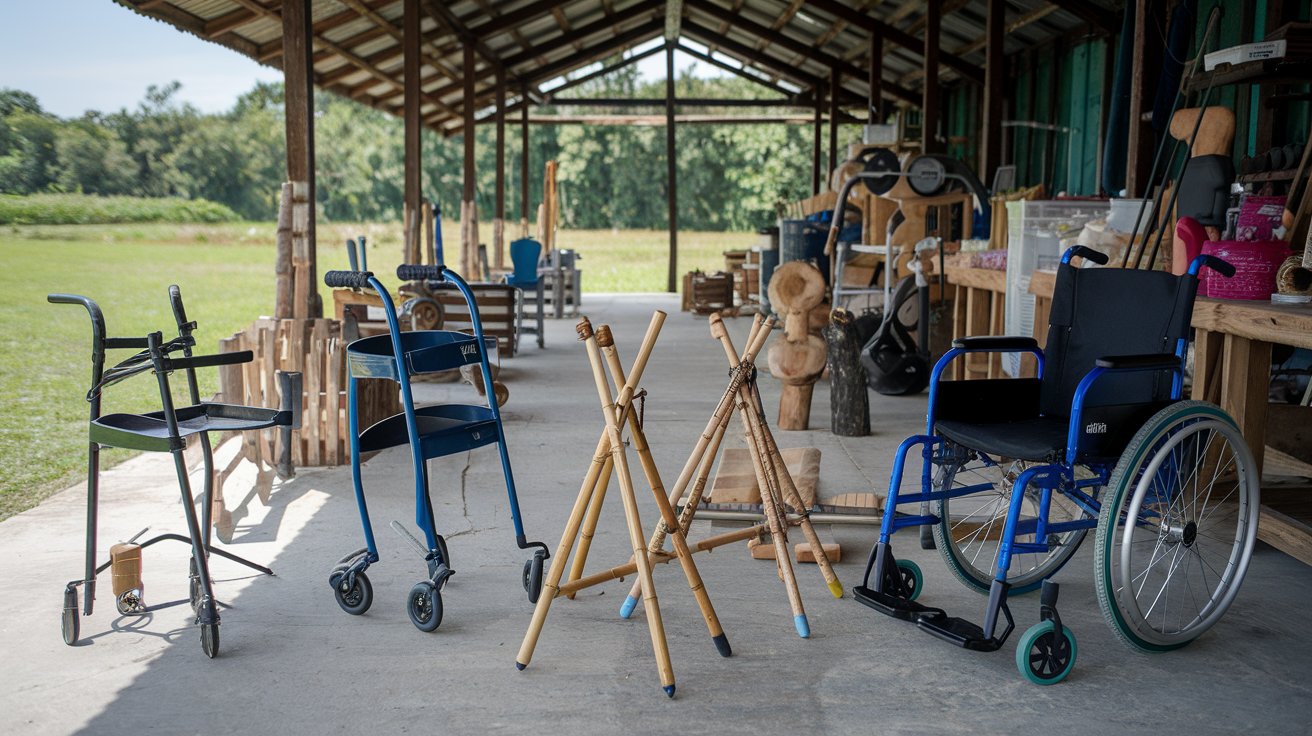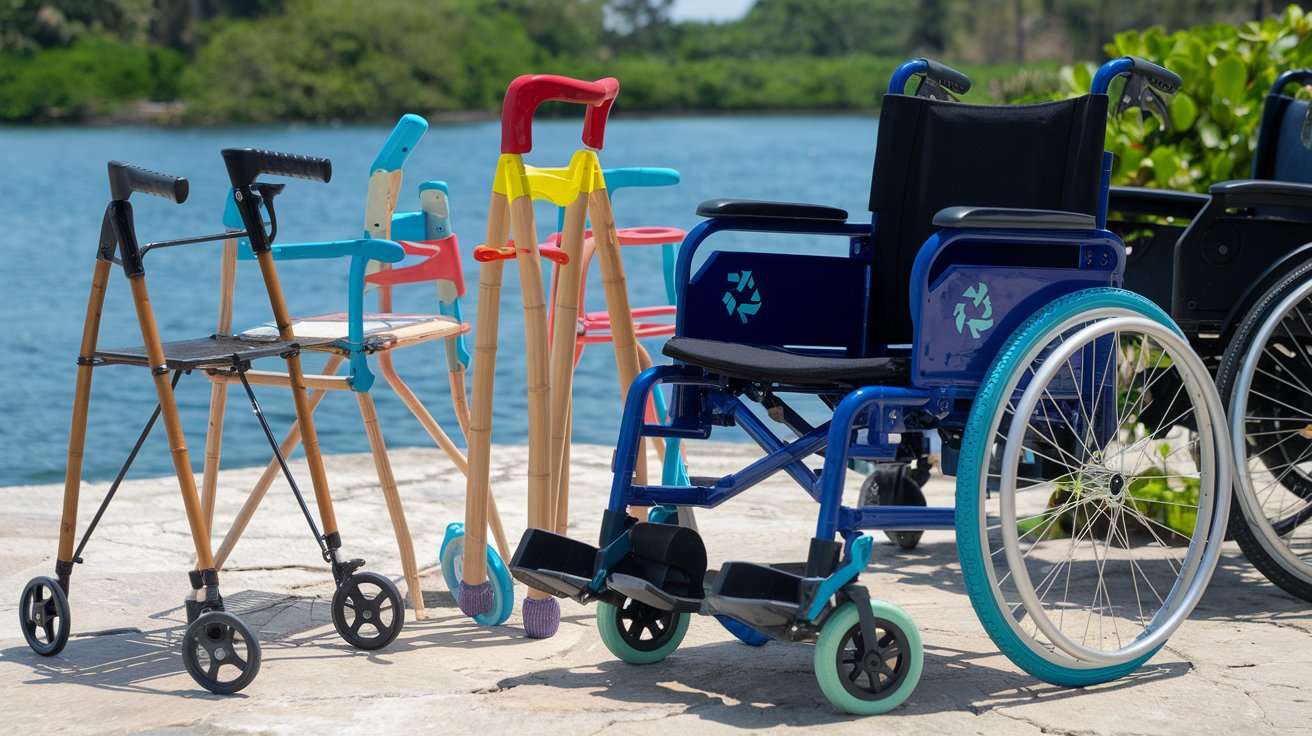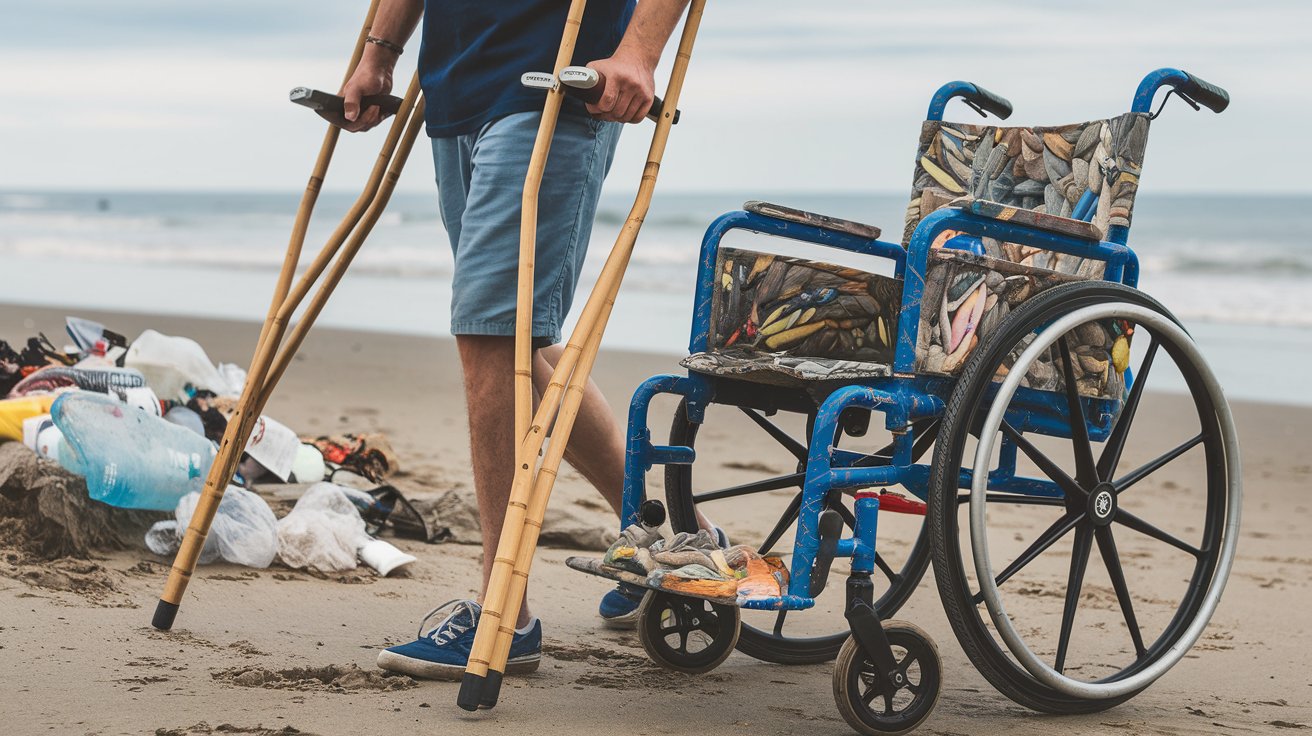What are the Best Mobility Aids for Seniors?A Guide with Pros and Cons

Mobility challenges are common among elderly individuals, affecting their ability to perform daily activities and maintain independence. Fortunately, mobility aids can significantly enhance safety, comfort, and quality of life. This guide explains the best mobility aids available and offers tips for selecting the right one based on individual needs.
Table of Contents
- Factors to Consider When Choosing Mobility Aids
- Types of Mobility Aids For Seniors
- 1. Canes: For Balance and Light Support
- 2. Walkers: For Extra Stability
- 3. Rollators: Mobility and Convenience Combined
- 4. Wheelchairs: For Long-Distance or Limited Mobility
- 5. Mobility Scooters: For Maximum Independence
- 6. Lift Chairs: For Comfort and Support at Home
- 7. Stairlifts: For Safe Access Between Floors
- 8. Bathroom Safety Aids: For Stability in Wet Areas
- How to Properly Use and Maintain Mobility Aids
- Benefits of Using Mobility Aids
Factors to Consider When Choosing Mobility Aids
Choosing the right mobility aid for a senior is an important decision that can significantly improve their quality of life. Involve the senior in the decision-making process. Their comfort and willingness to use the mobility aid are crucial. Encourage them to try different options to find the perfect fit!
Here are key factors to consider to ensure safety, comfort, and independence:
- Physical Needs and Health Conditions
- Assess the senior’s specific mobility challenges. Do they need support while walking, help with balance, or assistance with standing up?
- Consider any underlying health conditions, such as arthritis, Parkinson’s disease, or osteoporosis, as these may affect their strength and coordination.
- Consult a healthcare professional for recommendations tailored to their medical needs.
- Type of Mobility Aid
- Canes: Ideal for mild balance issues. Look for adjustable ones with comfortable grips.
- Walkers: Great for more stability. Some walkers come with wheels and seats for added convenience.
- Wheelchairs: Suitable for those who cannot walk long distances. Options range from manual to motorized.
- Scooters: A good choice for seniors who have enough upper body strength and need more independence over longer distances.
- Ease of Use
- Choose a mobility aid that is simple to operate. Seniors should feel confident using it without frustration or confusion.
- Test the mobility aid to ensure they can comfortably maneuver it in their living space.
- Comfort and Fit
- The device should suit their height and weight. For example, walkers and canes should allow the senior to stand upright without slouching.
- Check the padding, grips, and seats for comfort during extended use.
- Portability and Storage
- For seniors who travel often, lightweight and foldable aids are practical.
- Ensure the device can fit into vehicles or storage spaces without hassle.
- Home Environment
- Consider the layout of the senior’s home. Narrow doorways, stairs, or uneven flooring might require specific types of aids or modifications.
- A rollator with smaller wheels might work better indoors, while larger wheels are ideal for outdoor use.
- Durability and Maintenance
- Opt for sturdy, high-quality materials that can withstand daily use.
- Check how easy it is to maintain or repair the aid, as regular upkeep ensures longevity.
- Safety Features
- Look for non-slip grips, sturdy brakes, and wide bases for stability.
- Some aids come with safety alarms or lights for better visibility and peace of mind.
- Budget and Insurance
- Mobility aids come in a wide price range. Set a budget but don’t compromise on essential features.
- Check if insurance or Medicare covers part of the cost.
- Aesthetic Preferences
- Many seniors appreciate aids that match their personal style. Modern designs and color options can make them feel more confident using the device.
Types of Mobility Aids For Seniors
Mobility aids can significantly improve the quality of life for seniors, offering independence, comfort, and safety. Here’s a friendly guide to some of the best mobility aids, along with their pros and cons.
1. Canes: For Balance and Light Support
- Best For: Seniors with mild mobility or balance issues.
- Popular Choice: HurryCane Freedom Edition
- Adjustable height, pivoting base, and lightweight design make it a favorite.
Pros:
- Lightweight and portable.
- Easy to store and use.
- Provides mild support for improved confidence while walking.
Cons:
- Limited support for more severe mobility challenges.
- Requires some upper body strength for proper use.
2. Walkers: For Extra Stability
- Best For: Seniors needing more support than a cane provides.
- Popular Choice: Drive Medical Four-Wheel Walker
- Features a built-in seat, storage pouch, and easy brakes.
Pros:
- Provides excellent stability and balance.
- Built-in seat allows for rest breaks.
- Useful indoors and outdoors.
Cons:
- Bulky and less portable than canes.
- May be challenging to maneuver in tight spaces.
3. Rollators: Mobility and Convenience Combined
- Best For: Active seniors who need lightweight, versatile support.
- Popular Choice: NOVA Zoom Rollator
- Lightweight, with large wheels for indoor and outdoor use.
Pros:
- Lightweight and easy to maneuver.
- Larger wheels make it ideal for uneven surfaces.
- Comes with storage and seating options.
Cons:
- Less stable than standard walkers.
- Requires proper brake usage for safety.
4. Wheelchairs: For Long-Distance or Limited Mobility
- Best For: Seniors who have difficulty walking for extended periods.
- Popular Choice: Medline Lightweight Wheelchair
- Easy to push and fold, with a padded seat for comfort.
Pros:
- Offers full support for those with limited mobility.
- Foldable options are easy to transport.
- Comfortable for prolonged sitting.
Cons:
- Requires assistance for manual operation if the user can’t self-propel.
- Bulky compared to other aids.
5. Mobility Scooters: For Maximum Independence
- Best For: Seniors who need mobility for errands and social activities.
- Popular Choice: Pride Go-Go Elite Traveller
- Compact, easy to assemble, and highly maneuverable.
Pros:
- Provides great independence for longer distances.
- Easy to operate and customizable.
- Includes storage for carrying personal items.
Cons:
- Requires a battery that needs regular charging.
- Not suitable for tight indoor spaces or uneven terrain.
6. Lift Chairs: For Comfort and Support at Home
- Best For: Seniors with trouble standing up from seated positions.
- Popular Choice: La-Z-Boy Power Lift Recliner
- Offers customizable reclining and easy lift features.
Pros:
- Makes standing easier without strain.
- Comfortable for extended use.
- Stylish options to fit home décor.
Cons:
- Stationary, so it cannot assist with mobility outside the chair.
- Can be costly compared to other aids.
7. Stairlifts: For Safe Access Between Floors
- Best For: Seniors living in multi-level homes.
- Popular Choice: Stannah Stairlifts
- Smooth operation with customizable features.
Pros:
- Enhances access to all levels of the home.
- Operates smoothly and safely.
- Customizable for different types of stairs.
Cons:
- Expensive and requires professional installation.
- Limited to use on stairs, so it doesn’t help elsewhere.
8. Bathroom Safety Aids: For Stability in Wet Areas
- Best For: Seniors who need extra support in the bathroom.
- Popular Choice: Drive Medical Shower Chair and Grab Bars
- Offers sturdy and rust-proof design for bathroom safety.
Pros:
- Provides stability in slippery areas.
- Easy to install and maintain.
- Improves confidence in bathroom use.
Cons:
- Not portable outside the bathroom.
- Requires proper installation to ensure safety.
The best mobility aid depends on a senior’s specific needs, preferences, and lifestyle. Weighing the pros and cons can help make an informed decision that promotes safety, comfort, and independence. Always try different options before committing to the perfect mobility aid!
How to Properly Use and Maintain Mobility Aids
Using and maintaining mobility aids properly is key to ensuring they are safe, effective, and long-lasting. Here’s a simple guide to help seniors and caregivers get the most out of their mobility aids.
1. Learn How to Use the Mobility Aid Correctly
- Get Professional Guidance: Ask your doctor, physical therapist, or occupational therapist to demonstrate proper use. This ensures you’re using the aid safely and effectively.
- Adjust for Comfort: Make sure the device is adjusted to fit your height and body. For example, a cane or walker should allow you to stand upright without hunching.
- Practice in a Safe Space: Before venturing outdoors, practice using the aid in a controlled environment, like your home or a physical therapy clinic.
- Follow Weight Limits: Check the manufacturer’s guidelines to avoid overloading the device, especially for wheelchairs and scooters.
2. Establish a Routine for Safe Use
- Check Before Use: Ensure brakes, wheels, and handles are in good condition before every use.
- Be Mindful of Terrain: Use larger wheels for uneven surfaces and stick to flat, dry areas whenever possible.
- Move at Your Pace: Take your time and avoid rushing, especially on stairs or slippery surfaces.
- Wear Proper Footwear: Choose shoes with non-slip soles for extra stability.
3. Maintain the Mobility Aid Regularly
Proper maintenance keeps your mobility aid working efficiently and prevents accidents.
For Canes and Walkers:
- Check rubber tips for wear and replace them as needed to maintain grip.
- Wipe down the frame regularly to keep it clean.
- Tighten any loose screws or bolts to ensure stability.
For Rollators and Wheelchairs:
- Inspect brakes and wheels frequently for proper function.
- Clean wheels to remove dirt and debris that could hinder movement.
- Lubricate moving parts like hinges or axles to prevent stiffness.
For Scooters:
- Charge the battery regularly and avoid letting it drain completely.
- Check tires for wear or low pressure and replace them when necessary.
- Inspect lights and indicators to ensure visibility and safety.
For Lift Chairs and Stairlifts:
- Keep tracks and mechanisms free from dust or obstructions.
- Test remote controls and motors periodically for smooth operation.
- Schedule annual professional maintenance for complex systems.
4. Store the Mobility Aid Properly
- Keep it in a dry, cool place to prevent rust or damage.
- Foldable aids like walkers and wheelchairs should be stored securely to avoid accidental damage.
- Protect motorized aids from extreme temperatures that could affect the battery or electronics.
5. Replace or Upgrade When Necessary
- If the mobility aid no longer fits your needs or shows signs of wear that can’t be fixed, it’s time to upgrade.
- Stay informed about new features or technologies that might better suit your lifestyle.
6. Stay Open to Adjustments
- Regularly evaluate your mobility needs with your healthcare provider. Over time, you may need a different type of aid or additional features for optimal support.
- Customize grips, cushions, or add-ons like baskets or cup holders for added convenience.
Taking the time to learn proper usage and maintenance of your mobility aid helps ensure your safety and prolongs the device’s life. A well-maintained mobility aid not only supports your independence but also gives you peace of mind every time you use it. Happy moving!
Benefits of Using Mobility Aids
Mobility aids can make a world of difference in the lives of seniors, offering not just physical support but also emotional and social benefits.
1. Improved Mobility and Independence
- Mobility aids allow you to move around more easily, whether it’s navigating your home, running errands, or enjoying a stroll outdoors.
- They help reduce reliance on others, giving you the freedom to go where you want, when you want.
2. Enhanced Safety
- Devices like canes, walkers, and rollators provide extra stability, reducing the risk of falls and injuries.
- Features like non-slip grips, sturdy frames, and brakes on some aids add an extra layer of security.
3. Reduced Pain and Discomfort
- Mobility aids alleviate pressure on joints, especially for those with arthritis or other chronic conditions.
- Wheelchairs and scooters reduce strain from prolonged walking or standing, making daily activities more comfortable.
4. Increased Confidence
- Knowing you have the support of a reliable aid can boost your confidence in tackling daily tasks or venturing outdoors.
- It helps you maintain a positive outlook, knowing you can stay active without fear of losing balance or strength.
5. Better Social Engagement
- With improved mobility, you can attend family gatherings, meet friends, or participate in community events more easily.
- Staying socially active is vital for emotional well-being, and mobility aids help keep you connected.
6. Support for Daily Activities
- Lift chairs and stairlifts make home life easier by helping with standing, sitting, or moving between floors.
- Rollators with built-in seats allow you to rest during shopping trips or outdoor walks.
7. Tailored to Your Needs
- Mobility aids come in a variety of styles and functions, allowing you to find one that fits your specific requirements.
- From lightweight canes to motorized scooters, there’s a solution for every level of mobility.
8. Maintains Physical Activity
- Using mobility aids encourages movement rather than complete reliance on others, which helps keep your muscles active and healthy.
- Walkers and rollators, for example, support light exercise while ensuring stability.
9. Promotes Peace of Mind for Loved Ones
- Family and caregivers feel reassured knowing you have a safe and reliable way to move around.
- Mobility aids can reduce the need for constant assistance, fostering a sense of independence for everyone involved.
Final Thoughts
Mobility aids are not just tools—they’re companions that help you stay active, safe, and socially connected. Whether you need a little balance support or full mobility assistance, the right aid can bring greater ease and joy to your daily life. Embrace the freedom and confidence that comes with using a mobility aid!



